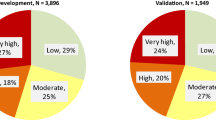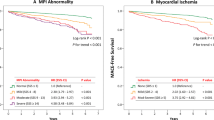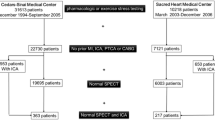Abstract
Background
Determining the risk of cardiovascular events is essential to optimize patient management.
Methods and Results
5842 individuals underwent SPECT myocardial perfusion imaging (MPI) with 4.4 ± 1.2 years of follow-up. Models (the CRAX tool) were derived to predict the cumulative risk of death and acute myocardial infarction (AMI) at 1, 3, and 5 years using clinical and MPI variables. Predictors of AMI and death included age, number of hospitalizations in the 3 years preceding MPI, and left ventricular ejection fraction (LVEF). Additional predictors of death were the use of pharmacological stress, and global stress total perfusion deficit (sTPD), while transient ischemic dilation (TID), and ischemic total perfusion deficit (iTPD) change were predictive of AMI. CRAX predictions were significantly (P < .001) more accurate than clinical variables or MPI results alone, resulting in a significant net reclassification improvement (NRI, 7.5% for AMI, 14.5% death) compared to clinical variables alone. Accuracy for predicting major adverse cardiac events (MACE, comprising all-cause death, AMI, unstable angina, late revascularization) was comparable to that of AMI or death.
Conclusions
CRAX is a risk assessment tool that predicts the risk of AMI, death, or MACE, and improves prediction compared to clinical variables or MPI results alone.

Similar content being viewed by others
Abbreviations
- CRAX:
-
Cardiovascular risk assessment
- SPECT:
-
Single-photon emission computed tomography
- MPI:
-
Myocardial perfusion imaging
- AMI:
-
Acute myocardial infarction
- MACE:
-
Major adverse cardiac event
- LVEF:
-
Left ventricular ejection fraction
- TID:
-
Transient ischemic dilatation
- NRI:
-
Net reclassification improvement
- iTPD:
-
Ischemic total perfusion defect
- sTPD:
-
Stress total perfusion defect
References
Mendis S, Puska P, Norrving B (2011) Global atlas on cardiovascular disease prevention and control. Glob Atlas Cardiovasc Dis Prev Control.
Sharir T, Germano G, Kang X, et al. Prediction of myocardial infarction versus cardiac death by gated myocardial perfusion SPECT: risk stratification by the amount of stress-induced ischemia and the poststress ejection fraction. J Nucl Med 2001;42:831-7.
Hachamovitch R, Berman DS, Kiat H, et al. Exercise myocardial perfusion SPECT in patients without known coronary artery disease. Circulation 1996;93:905-14. https://doi.org/10.1161/01.CIR.93.5.905.
Berman D, Hachamovitch R, Lewin H, et al. Risk stratification in coronary artery disease: implications for stabilization and prevention. Am J Cardiol 1997;79:10-6. https://doi.org/10.1016/S0002-9149(97)00380-9.
Mahmarian JJ, Moye´ LA, Verani MS, et al. High reproducibility of myocardial perfusion defects in patients undergoing serial exercise thallium-201 tomography. Am J Cardiol 1995;75:1116-9. https://doi.org/10.1016/S0002-9149(99)80741-3.
Arsanjani R, Xu Y, Hayes SW, et al. Comparison of fully automated computer analysis and visual scoring for detection of coronary artery disease from myocardial perfusion SPECT in a large population. J Nucl Med 2013;54:221-8. https://doi.org/10.2967/jnumed.112.108969.
Berman D, Kang X, Van Train K, et al. Comparative prognostic value of automatic quantitative analysis versus semiquantitative visual analysis of exercise myocardial perfusion single-photon emission computed tomography. J Am Coll Cardiol 1998;32:1987-95. https://doi.org/10.1016/S0735-1097(98)00501-4.
Leslie WD, Tully SA, Yogendran MS, et al. Prognostic value of automated quantification of 99mTc-sestamibi myocardial perfusion imaging. J Nucl Med 2005;46:204-11.
WHO. WHO SCIENTIFIC GROUP ON THE ASSESSMENT OF OSTEOPOROSIS AT PRIMARY HEALTH CARE LEVEL. Brussels: Belgium; 2004.
Kanis JA, Oden A, Johnell O, et al. The use of clinical risk factors enhances the performance of BMD in the prediction of hip and osteoporotic fractures in men and women. Osteoporos Int J Establ Result Coop Eur Found Osteoporos Natl Osteoporos Found USA 2007;18:1033-46. https://doi.org/10.1007/s00198-007-0343-y.
Motwani M, Leslie W, Goertzen A, et al (2017) Fully automated analysis of attenuation-corrected SPECT for the long-term prediction of acute myocardial infarction. J Nucl Cardiol 1-8. https://doi.org/10.1007/s12350-017-0840-0.
Xu Y, Kavanagh P, Fish M, et al. Automated quality control for segmentation of myocardial perfusion SPECT. J Nucl Med 2009;50:1418-26. https://doi.org/10.2967/jnumed.108.061333.
Slomka PJ, Fish MB, Lorenzo S, et al. Simplified normal limits and automated quantitative assessment for attenuation-corrected myocardial perfusion SPECT. J Nucl Cardiol 2006;13:642-51. https://doi.org/10.1016/j.nuclcard.2006.06.131.
Slomka PJ, Nishina H, Berman DS, et al. Automated quantification of myocardial perfusion SPECT using simplified normal limits. J Nucl Cardiol 2005;12:66-77. https://doi.org/10.1016/j.nuclcard.2004.10.006.
Kozyrskyj AL, Mustard CA. Validation of an electronic, population-based prescription database. Ann Pharmacother 1998;32:1152-7. https://doi.org/10.1345/aph.18117.
Tu JV, Austin PC, Walld R, et al. Development and validation of the ontario acute myocardial infarction mortality prediction rules. J Am Coll Cardiol 2001;37:992-7. https://doi.org/10.1016/S0735-1097(01)01109-3.
Roos LL, Mustard CA, Nicol JP, et al. Registries and administrative data: organization and accuracy. Med Care 1993;31:201-12.
Pencina MJ, D’Agostino RB, D’Agostino RB, Vasan RS (2008) Evaluating the added predictive ability of a new marker: from area under the ROC curve to reclassification and beyond. Stat Med 27:157-172; discussion 207-212. https://doi.org/10.1002/sim.2929.
Leening MJG, Vedder MM, Witteman JCM, et al. Net reclassification improvement: computation, interpretation, and controversies: a literature review and clinician’s guide. Ann Intern Med 2014;160:122-31. https://doi.org/10.7326/M13-1522.
Vanzetto G, Ormezzano O, Fagret D, et al. Long-term additive prognostic value of thallium-201 myocardial perfusion imaging over clinical and exercise stress test in low to intermediate risk patients: Study in 1137 patients with 6-year follow-up. Circulation 1999;100:1521-7. https://doi.org/10.1161/01.CIR.100.14.1521.
Miller WL, Tointon SK, Hodge DO, et al. Long-term outcome and the use of revascularization in patients with heart failure, suspected ischemic heart disease, and large reversible myocardial perfusion defects. Am Heart J 2002;143:904-9. https://doi.org/10.1067/mhj.2002.120153.
Miller TD, Christian TF, Hodge DO, et al. Prognostic value of exercise thallium-201 imaging performed within 2 years of coronary artery bypass graft surgery. J Am Coll Cardiol 1998;31:848-54. https://doi.org/10.1016/S0735-1097(98)00011-4.
Elhendy A, Schinkel AFL, van Domburg RT, et al. Risk stratification of patients with angina pectoris by stress 99 mTc-tetrofosmin myocardial perfusion imaging. J Nucl Med 2005;46:2003-8.
Betancur J, Otaki Y, Motwani M, et al. Prognostic value of combined clinical and myocardial perfusion imaging data using machine learning. JACC Cardiovasc Imaging 2018;11:1000-9. https://doi.org/10.1016/j.jcmg.2017.07.024.
Koh AS, Gao F, Chin CT, et al. Differential risk reclassification improvement by exercise testing and myocardial perfusion imaging in patients with suspected and known coronary artery disease. J Nucl Cardiol Off Publ Am Soc Nucl Cardiol 2016;23:366-78. https://doi.org/10.1007/s12350-015-0253-x.
Shaw LJ, Wilson PWF, Hachamovitch R, et al. Improved near-term coronary artery disease risk classification with gated stress myocardial perfusion SPECT. JACC Cardiovasc Imaging 2010;3:1139-48. https://doi.org/10.1016/j.jcmg.2010.09.008.
Hachamovitch R, Berman DS, Kiat H, et al. Exercise myocardial perfusion SPECT in patients without known coronary artery disease: Incremental prognostic value and use in risk stratification. Circulation 1996;93:905-14. https://doi.org/10.1161/01.CIR.93.5.905.
Xu Y, Hayes S, Ali I, et al. Automatic and visual reproducibility of perfusion and function measures for myocardial perfusion SPECT. J Nucl Cardiol 2010;17:1050-7. https://doi.org/10.1007/s12350-010-9297-0.
Setoguchi S, Stevenson LW, Schneeweiss S. Repeated hospitalizations predict mortality in the community population with heart failure. Am Heart J 2007;154:260-6. https://doi.org/10.1016/j.ahj.2007.01.041.
Bhatti N, Amoateng-Adjepong Y, Qamar A, Manthous CA. Myocardial infarction in critically iII patients presenting with gastrointestinal hemorrhage: retrospective analysis of risks and outcomes. Chest 1998;114:1137-42. https://doi.org/10.1378/chest.114.4.1137.
Valdiviezo C, Motivala AA, Hachamovitch R, et al. The significance of transient ischemic dilation in the setting of otherwise normal SPECT radionuclide myocardial perfusion images. J Nucl Cardiol 2011;18:220-9. https://doi.org/10.1007/s12350-011-9343-6.
Travin MI, Heller GV, Johnson LL, et al. The prognostic value of ECG-gated SPECT imaging in patients undergoing stress Tc-99m sestamibi myocardial perfusion imaging. J Nucl Cardiol 2004;11:253-62. https://doi.org/10.1016/j.nuclcard.2004.02.005.
Denollet J, Brutsaert DL. Personality, disease severity, and the risk of long-term cardiac events in patients with a decreased ejection fraction after myocardial infarction. Circulation. 1998;97:167–73. https://doi.org/10.1161/01.CIR.97.2.167.
Betancur J, Commandeur F, Motlagh M, et al (2018) Deep learning for prediction of obstructive disease from fast myocardial perfusion SPECT: a multicenter Study. JACC Cardiovasc Imaging. https://doi.org/10.1016/j.jcmg.2018.01.020.
Navare SM, Mather JF, Shaw LJ, et al. Comparison of risk stratification with pharmacologic and exercise stress myocardial perfusion imaging: a meta-analysis. J Nucl Cardiol 2004;11:551-61. https://doi.org/10.1016/j.nuclcard.2004.06.128.
Berman DS, Kang X, Hayes SW, et al. Adenosine myocardial perfusion single-photon emission computed tomography in women compared with men: Impact of diabetes mellitus on incremental prognostic value and effect on patient management. J Am Coll Cardiol 2003;41:1125-33. https://doi.org/10.1016/S0735-1097(03)00085-8.
Acknowledgements
The authors acknowledge the Manitoba Centre for Health Policy for use of data contained in the Population Health Research Data Repository (HIPC 2012/2013 -18). The results and conclusions are those of the authors and no official endorsement by the Manitoba Centre for Health Policy, Manitoba Health, Healthy Living, and Seniors, or other data providers are intended or should be inferred.
Disclosures
P. Martineau, W. Leslie, and A. Goertzen declare that they have no conflict of interest. P. Slomka participates in software royalties at Cedars-Sinai Medical Center for the licensing of the software for myocardial perfusion quantification.
Author information
Authors and Affiliations
Corresponding author
Additional information
The authors of this article have provided a PowerPoint file, available for download at SpringerLink, which summarises the contents of the paper and is free for re-use at meetings and presentations. Search for the article DOI on SpringerLink.com.
Funding
This research was supported in part by the National Institutes of Health (NIH) grant R01 HL089765 (PS).
Electronic supplementary material
Below is the link to the electronic supplementary material.
12350_2018_1556_MOESM1_ESM.xlsx
Supplementary material 1 The CRAX tool predicts risk of AMI or death more accurately than clinical or imaging variables alone (XLSX 17 kb)
Rights and permissions
About this article
Cite this article
Martineau, P., Slomka, P., Goertzen, A. et al. CRAX: A simple cardiovascular risk assessment tool to predict risk of acute myocardial infarction or death. J. Nucl. Cardiol. 27, 2365–2374 (2020). https://doi.org/10.1007/s12350-018-01556-0
Received:
Accepted:
Published:
Issue Date:
DOI: https://doi.org/10.1007/s12350-018-01556-0




